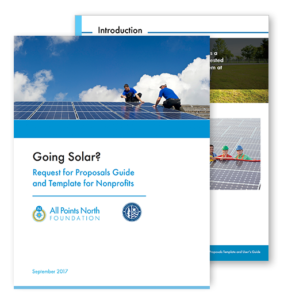Going Solar?
Going Solar?
Request for Proposals Guide and Template for Nonprofits
This resource outlines key steps and considerations that nonprofits should prepare for when installing solar on their facility.
While this information is not a substitute for professional consultation, assessment and design, it can get you started by helping you familiarize yourself with the process.
Phase 1: Exploration of a Commerical-scale Project
In this first phase, assess whether a solar project is a good fit for your organization. Note that if you are a tenant – not the owner – of your building, you will need to work closely with the landlord/owner as you consider improvements to the structure.
In this exploratory phase, you will need to:
Phase 2: Preparation/Action Plan for Installing a Solar PV System
Following the decision to move forward with the installation of a solar PV system, the focus shifts to the steps needed to ensure a timely and on-budget installation.
In this second phase, the action plan your in-house project manager creates to complete the project should include the following steps:
Phase 3: Contractor Selection, Solar Installation
The following outlines steps to consider and plan for once your RFP is issued and contractors have responded.
In this third and final phase, plan to:
All Points North Foundation provides grants for U.S.-based projects and initiatives that support our priorities: improving public middle school education and teacher training, and implementing effective solar programs and/or projects.
Have a U.S.-based project you’d like to discuss?


